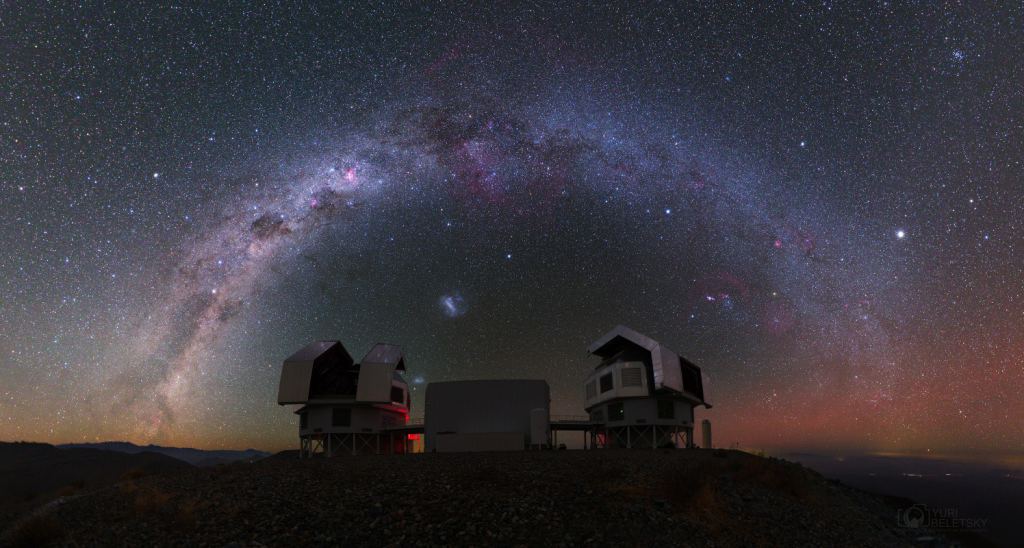Ever since astronomers realized that the Universe is in a constant state of expansion and that a massive explosion likely started it all 13.8 billion years ago (the Big Bang), there have been unresolved questions about when and how the first stars formed. Based on data gathered by NASA’s Wilkinson Microwave Anisotropy Probe (WMAP) and similar missions, this is believed to have happened about 100 million years after the Big Bang.
Much of the details of how this complex process worked have remained a mystery. However, new evidence gathered by a team led by researchers from the Max Planck Institute for Astronomy indicates that the first stars must have formed rather quickly. Using data from the Magellan Telescopes at Las Campanas Observatory, the team observed a cloud of gas where star formation was taking place just 850 million years after the Big Bang.
The study that described their findings, which recently appeared in the Astrophysical Journal, was led by Eduardo Bañados. A member at the Carnegie Institution for Science at the time, Banados and his colleagues observed the gas cloud while conducting follow-up observations on a survey of 15 of the most distant quasars known.
This survey had been prepared by Chiara Mazzucchelli, an astronomer with the European Southern Observatory (ESO) and a co-author on the study, as part of her Ph.D. research at the Max Planck Institute for Astronomy. While examining the spectra of one quasar in particular (P183+05), they noted that it had some rather peculiar features.
Using the Carnegie Institution’s 6.5 m Magellan Telescopes at the Las Campanas Observatory in Chile, Banados and his colleagues recognized the spectral features for what they were: a nearby gas cloud that was being illuminated by the quasar. The spectra also told them how far the gas cloud was from Earth – over 13 billion light-years away – making it one of the most distant to ever be observed and identified by astronomers.
In addition, they found spectra that indicated the presence of trace amounts of elements like carbon, oxygen, iron, and magnesium – chemically designated as “metals” since they are heavier than helium. Such elements were created during the early Universe as the first generations of stars (aka. “population III”) released them into the cosmos after they reached the end of their lifespan and exploded as supernovae.

As Michael Rauch, an astronomer from the Carnegie Institution of Science and a co-author of the new study, said:
“After we were convinced that [we] were looking at such pristine gas only 850 million years after the Big Bang we started wondering whether this system could still retain chemical signatures produced by the very first generation of stars.”
Finding the first generation of stars has long been the goal of astronomers since it would allow for a more comprehensive understanding of the history of the Universe. As time went on, elements heavier than hydrogen played a key role in the formation of stars, where matter clumps together due to mutual attraction and then undergoes gravitational collapse.
Since only hydrogen and helium are believed to have existed in the Universe after the Big Bang, the first generation of stars did not have these chemical elements – which makes them distinct from every generation that followed. It was therefore surprising to note a relative abundance of these elements in such an early gas cloud, which was actually comparable to what astronomers see in intergalactic gas clouds today.

These observations pose a major challenge to conventional theories of how the first stars in our Universe formed. Essentially, it indicates that star formation must have begun much earlier in order to produce these chemical elements. Based on studies involving type Ia supernovae, it is estimated that the explosions necessary to produce these metals with the observed abundance would take about 1 billion years to happen.
In short, scientists may have been off by about a generation when it comes to when the first stars were born, implying that there may have been some around during the earliest eons of the Universe. This effectively means that the first stars would have had to form rather quickly from the primordial soup of hydrogen and helium that was the early Universe. This finding could have serious implications for theories on cosmic evolution.
As Bañados said, the goal now is to confirm this by finding additional gas clouds that have similar chemical abundances:
“It is exciting that we can measure metallicity and chemical abundances so early in the history of the universe, but if we want to identify the signatures of the first stars we need to probe even earlier in cosmic history. I am optimistic that we will find even more distant gas clouds, which could help us understand how the first stars were born.”
Relativity tells us that space and time are two expressions of the same reality. Ergo, by looking farther out into the Universe, we are also looking farther back in time. In so doing, astronomers have been able to adjust their cosmological models and ideas about how and when everything began. Knowing that the first stars in the Universe could have their origins pushed back to an even earlier time; well, that’s just part of the learning curve!
Further Reading: Max Planck Society, Astrophysical Journal

